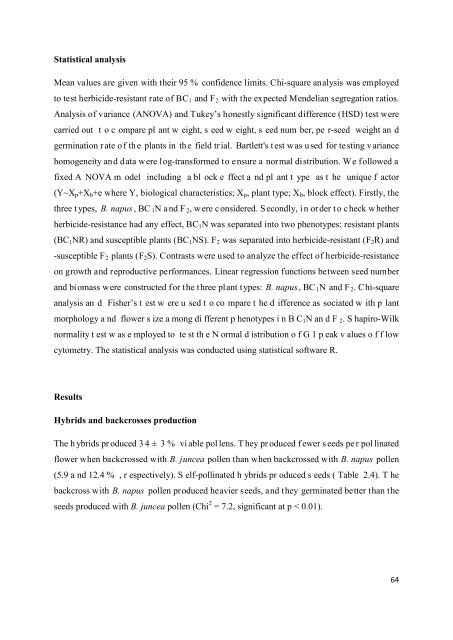UNIVERSITE DE BOURGOGNE THÈSE Yongbo LIU - Université de ...
UNIVERSITE DE BOURGOGNE THÈSE Yongbo LIU - Université de ...
UNIVERSITE DE BOURGOGNE THÈSE Yongbo LIU - Université de ...
You also want an ePaper? Increase the reach of your titles
YUMPU automatically turns print PDFs into web optimized ePapers that Google loves.
Statistical analysis<br />
Mean values are given with their 95 % confi<strong>de</strong>nce limits. Chi-square analysis was employed<br />
to test herbici<strong>de</strong>-resistant rate of BC1 and F2 with the expected Men<strong>de</strong>lian segregation ratios.<br />
Analysis of variance (ANOVA) and Tukey’s honestly significant difference (HSD) test were<br />
carried out t o c ompare pl ant w eight, s eed w eight, s eed num ber, pe r-seed weight an d<br />
germination rate o f th e plants in th e field trial. Bartlett's t est was u sed for testing v ariance<br />
homogeneity and data were log-transformed to ensure a normal distribution. We followed a<br />
fixed A NOVA m o<strong>de</strong>l including a bl ock e ffect a nd pl ant t ype as t he unique f actor<br />
(Y~Xp+Xb+e where Y, biological characteristics; Xp, plant type; Xb, block effect). Firstly, the<br />
three t ypes, B. napus , BC 1N a nd F 2, w ere c onsi<strong>de</strong>red. S econdly, i n or <strong>de</strong>r t o c heck w hether<br />
herbici<strong>de</strong>-resistance had any effect, BC1N was separated into two phenotypes: resistant plants<br />
(BC1NR) and susceptible plants (BC1NS). F2 was separated into herbici<strong>de</strong>-resistant (F2R) and<br />
-susceptible F2 plants (F2S). Contrasts were used to analyze the effect of herbici<strong>de</strong>-resistance<br />
on growth and reproductive performances. Linear regression functions between seed number<br />
and biomass were constructed for the three plant types: B. napus, BC 1N and F 2. Chi-square<br />
analysis an d Fisher’s t est w ere u sed t o co mpare t he d ifference as sociated w ith p lant<br />
morphology a nd flower s ize a mong di fferent p henotypes i n B C1N an d F 2. S hapiro-Wilk<br />
normality t est w as e mployed to te st th e N ormal d istribution o f G 1 p eak v alues o f f low<br />
cytometry. The statistical analysis was conducted using statistical software R.<br />
Results<br />
Hybrids and backcrosses production<br />
The h ybrids pr oduced 3 4 ± 3 % vi able pol lens. T hey pr oduced f ewer s eeds pe r pol linated<br />
flower when backcrossed with B. juncea pollen than when backcrossed with B. napus pollen<br />
(5.9 a nd 12.4 % , r espectively). S elf-pollinated h ybrids pr oduced s eeds ( Table 2.4). T he<br />
backcross with B. napus pollen produced heavier seeds, and they germinated better than the<br />
seeds produced with B. juncea pollen (Chi 2 = 7.2, significant at p < 0.01).<br />
64
















